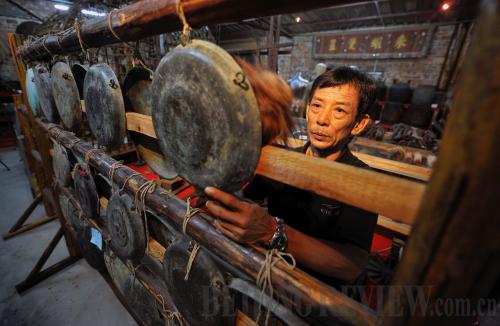|
 |
|
ONE-MAN SHOW: Yuan Jinhua, a retired postal worker in Hainan Province, wipes dust off a bronze musical instrument at his own museum on the cultural heritage of local Li ethnic group. A collection of more than 3,000 exhibits cost Yuan over 30 years and most of his personal income (GUO CHENG) |
A museum sponsored by a village in north China's Hebei Province has been shut down amid allegations that all is not what it seems when it comes to the ancient porcelain pieces on display.
Open to the public since July 2010, the Jibaozhai Museum in Erpu Village, Jizhou City, has 12 exhibition halls full of what it claimed were unique cultural gems.
However, the authenticity of its exhibited items had been challenged by renowned China experts. The village museum's academic rigor went unnoticed until a blog post about a visit to the museum went viral.
On July 7, prominent writer Ma Boyong posted a parody Life of Ma in a nod to the famous fantasy adventure novel Life of Pi by Yann Martel implying that the only thing more unbelievable than a castaway sharing a boat with a live tiger was the appalling fakery exhibited at the village museum.
Among the inconsistencies writer Ma noted was an item that claimed to be produced during the reign of Yongzheng Emperor (1722-35) of the Qing Dynasty (1644-1911) featuring female characters from Dream of the Red Chamber, a pinnacle of Chinese fiction written in the 1780s.
There was also an alleged Tang Dynasty (618-907) porcelain vase that features a five-color pattern, despite the fact this technique was invented hundreds of years later during the Ming Dynasty (1368-1644).
During the discussions following Ma's article, experts alleged that many of the items in Jibaozhai are actually knock-offs worth between 100 yuan ($16) and 2,000 yuan ($327).
On July 10, the Jizhou City Government announced an investigation into forgeries housed by the museum.
Collector of the untrue
Wang Zongquan, a village head in Eupu for four decades, has played a pivotal role in founding Jibaozhai. Wang, an enthusiastic collector of ancient Chinese porcelain himself and curator of the museum, spent a total of 20 million yuan ($3.26 million) from the village's treasury over the past three decades in acquiring the collection. The addition to the collection stopped several years ago due to a tightened budget.
In China, villages are run by "self-governing villagers' committees," thus the "village museum" is legally a private entity.
The Museum's chief consultant Wei Yingjun said that he was positive that many of the 40,000 objects in its collection were authentic and those described in the blog were merely a minority whose authenticity was deemed questionable by the museum itself.
"We still exhibit them because we want visitors to help verify their actual dates of production," Wei told newspaper Time Weekly.
Wei said that another reason behind the widespread forgery among the museum's collection is that identification and verification by experts would have cost 40 million yuan ($6.53 million).
According to Wei, the museum's annual operational expense tops 3 million yuan ($489,600) and receives only 800,000 yuan ($130,560) in government subsidies every year. Before its closure, the museum had relied on the village's treasury to meet its deficit as ticket revenue is insignificant. Wei said that the museum's first rectification move was to send 1,000 exhibited items for identification as they could not afford more.
The scandal over the village museum sheds light on difficulties faced by private museums around China. A relatively new breed, many private museums are struggling financially due to the lack of stable sources of funding in China. Very few of them have a modern management methods to survive.
Survival pressure
China's first private museum came into being in Shanghai in 1992. According to statistics by the State Administration of Cultural Heritage, China had a total of 3,589 museums at the end of 2011, of which 14.9 percent or 535 were privately funded.
Peng Feng, Dean of the Department of Art Theory, History and Criticism at the School of Arts of Peking University, said that the development of private museums in China lags far behind their counterparts in Europe and the United States.
Even in metropolitan areas of China such as Beijing and Shanghai where private museums are relatively mature, their daily expenses are mainly paid by their wealthy owners.
| 